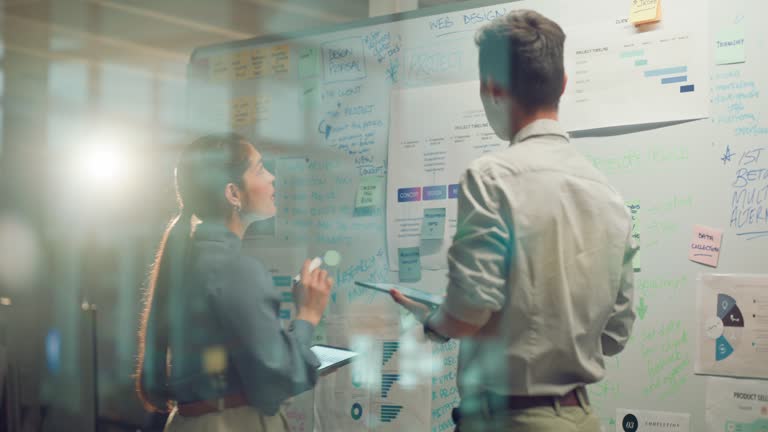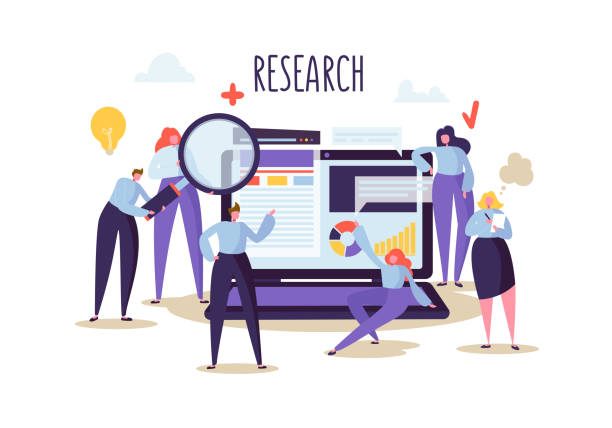The Importance of Multilingual Website Design in the Digital Age

In today’s world, where geographical boundaries have less meaning in the virtual space, an integrated and widespread digital presence is vital for businesses.
#Multilingual_Website_Design is no longer a luxury option, but a strategic necessity.
Imagine your potential customers in different countries being unable to understand your website’s content; this means missing out on countless opportunities in the global market.
A multilingual website creates a communication bridge between you and your global audience, allowing you to convey your message in a language they understand.
This not only increases access to new markets but also significantly improves customer trust and loyalty.
This approach offers numerous benefits not only for large, international companies but also for small and medium-sized businesses.
Given the ever-expanding reach of the internet and easy access to information worldwide, users expect to find content in their native language.
Failure to provide multilingual content means limiting business growth potential and losing a significant market share. Today, websites must cater to diverse cultural and linguistic needs to succeed in intense online competition.
Multilingual website design is a smart investment that yields a significant return in the form of increased traffic, improved SEO, and ultimately, sales growth.
This is a crucial step towards entering the world of international business and expanding your digital influence.
Tired of missing out on business opportunities due to not having a professional corporate website? Worry no more! With Rasaweb’s corporate website design services:
✅ Your brand’s credibility and professionalism will increase.
✅ You will attract more customers and sales leads.
⚡ Get a free consultation now to get started!
Challenges and Opportunities in Implementing Multilingual Website Design

Implementing #Multilingual_Website_Design, while full of golden opportunities, also presents specific challenges that must be carefully considered.
One of the biggest challenges is managing translated content and maintaining its quality.
Translation is not just about words; conveying meaning and adapting to local cultures (localization) are also crucial.
A poor machine translation or content that is not culturally adapted can severely damage your brand’s credibility.
Furthermore, technical issues such as URL structure, the use of hreflang tags, and SEO management for different languages have their own complexities that require technical expertise.
However, the opportunities arising from overcoming these challenges are countless.
A multilingual website allows you to enter new markets that were previously inaccessible to you.
This helps increase your brand awareness globally and paves the way for sales growth and service expansion.
Moreover, multilingual websites generally perform better in international search results, as search engines can index your content in various languages and present it to relevant users.
This leads to increased organic traffic and attracting higher-quality customers.
For success in multilingual website design, meticulous planning, selecting appropriate tools, and collaborating with translation and SEO specialists are essential.
These steps ensure that your website is not only available in multiple languages but also performs effectively and attractively in each language.
Key Steps in the Successful Multilingual Website Design Process

The #Multilingual_Website_Design process requires a structured approach and meticulous planning to ensure its success.
The first essential step is market research and identifying target languages.
You need to know which geographical regions your target audience is in and what languages they speak.
This stage also includes competitor analysis and examining user needs in different markets.
After that, it’s time to choose the implementation strategy; will you use subdomains (e.g., en.yoursite.com), subdirectories (e.g., yoursite.com/en), or top-level domains (e.g., yoursite.co.uk)? Each of these methods has its own SEO and technical advantages and disadvantages.
The next step is content production and management.
Mere translation is not enough; your content must be localized to match cultural differences, local idioms, and even units of measurement and currency prevalent in each region.
Using a suitable Content Management System (CMS) that supports multilingual capabilities is crucial at this stage.
Finally, technical optimization for search engines (SEO) and hreflang tags to direct users to the correct language version of the website are of particular importance.
Thorough and continuous testing of the website in all languages and browsers is also essential to ensure correct functionality and optimal user experience.
This multifaceted process will guarantee the success of your multilingual website design project.
Below is a general guide table for choosing a URL strategy:
| URL Strategy | Advantages | Disadvantages | Use Cases |
|---|---|---|---|
| Top-Level Domains (TLD)
(example.de, example.fr) |
|
|
|
| Subdirectories
(example.com/en/, example.com/fr/) |
|
|
|
| Subdomains
(en.example.com, fr.example.com) |
|
|
|
Content Optimization for Search Engines in Multilingual Website Design

#Multilingual_Website_Design without Search Engine Optimization (SEO) in each language is like a boat without sails at sea.
For your website to appear in search results for global users, you must correctly implement multilingual SEO strategies.
One of the most important techniques is using the hreflang tag.
This tag informs search engines like Google which version of your page is suitable for which language and geographical region.
This prevents the “duplicate content” issue and helps the search engine display the correct version to the appropriate user.
In addition to hreflang, correct keyword translation for each language is also essential.
This does not mean word-for-word translation, but rather researching frequently used keywords in each specific language and culture.
For instance, a term might have different meanings in one language or a more common equivalent in another.
Appropriate URL structure (as mentioned in the previous table), site loading speed, and mobile compatibility are also crucial factors for SEO in all languages.
Building high-quality backlinks from reputable sites in each language can also help improve SEO rankings.
Technical and content optimization of a multilingual website is an ongoing process that requires continuous monitoring and updates to maintain competitiveness in international markets.
Ignoring SEO in multilingual website design can lead to losing your investment.
Are you concerned about your e-commerce site’s low conversion rate and not achieving your desired sales?
Rasaweb is your specialized solution for having a successful e-commerce site.
✅ Significant increase in conversion rates and sales
✅ Professional and user-friendly design to attract customer satisfaction
⚡ Ready for a transformation in online sales? Get a free consultation!
Essential Tools for Multilingual Content Management

Managing content on a multilingual website can be complex, but with the right tools and systems, the process becomes significantly simpler.
The first and most important tool is a #Content_Management_System (CMS) that natively supports multilingual capabilities or has powerful plugins for this purpose.
Platforms like WordPress with plugins such as WPML or Polylang, as well as Drupal and Joomla, which have built-in multilingual features, are popular choices.
These systems allow you to easily create, edit, and organize content in various languages.
In addition to CMS, translation tools also play a key role.
While machine translation like Google Translate can be useful for general understanding, for professional and localized content, it’s necessary to use Computer-Assisted Translation (CAT Tools) such as Trados or MemoQ, or to collaborate with professional translators and reputable translation agencies.
These tools enable the management of Translation Memory and Glossaries, which help maintain consistency in terminology and reduce translation costs in the long run.
Testing and validation tools are also essential to ensure the correct display of content and functionality of links in all languages.
Proper selection and use of these tools significantly enhance the efficiency of the multilingual website design process.
The Impact of Multilingual Website Design on User Experience and Customer Interaction

One of the most important aspects of #Multilingual_Website_Design is its profound impact on User Experience (UX) and customer interaction.
When a user visits a website offered in their native language, they feel a greater sense of comfort and belonging.
This not only encourages the user to spend more time on the site and explore its content but also significantly increases their likelihood of converting into a customer.
Localized content, including images, currency, dates, and even graphic design that aligns with the local culture, demonstrates your attention to international audiences.
Have you ever considered how much a small translation error or a lack of understanding of cultural differences can harm your credibility? A poor user experience due to irrelevant or incomprehensible content can quickly lead to users leaving your site and turning to competitors. In contrast, a well-designed multilingual website conveys a sense of professionalism and trust.
This not only increases user engagement (such as filling out forms, purchasing products, or subscribing to newsletters) but also helps improve conversion rates and reduce bounce rates.
Ultimately, increasing customer satisfaction and building a lasting and meaningful relationship with them is the most important outcome of multilingual website design with a focus on user experience.
This is an investment in building long-term relationships with loyal customers.
Case Studies of Multilingual Website Design Success in Various Industries

To better understand the potential of #Multilingual_Website_Design, examining successful examples in various industries can be highly inspiring.
Large global companies such as Apple or IKEA are pioneers in this field.
They have not only translated their websites into dozens of languages but also optimize the user experience based on the local cultures of each country.
This deep localization allows them to establish strong connections with consumers worldwide and expand their market share.
These examples demonstrate that success lies not merely in providing translation, but in offering a fully localized experience.
In the tourism industry, companies like Booking.com, by offering their services and content in over 40 languages, are excellent examples of the impact of multilingual website design.
This approach enables them to reach millions of travelers worldwide and become the largest online booking platform.
Even small and medium-sized businesses can achieve success using this strategy.
For example, a handicraft producer in Iran, who translated and localized their website into English and Arabic, has been able to sell their products to European and Arab customers.
These stories prove that multilingual website design is a sure path to reaching new markets and increasing sales on a global scale, regardless of business size.
The following table presents some examples of successful companies in implementing multilingual websites and their impact on their businesses:
| Company | Industry | Multilingual Approach | Impact on Business |
|---|---|---|---|
| Airbnb | Tourism/Accommodation Rental | Website and app in over 60 languages, strong content localization, and customer support |
|
| Netflix | Entertainment/Online Streaming | Multilingual content (subtitles and dubbing), user interface in various languages, content suggestions based on region |
|
| SAP | Enterprise Software | Localized technical documentation, websites, and software for large corporate markets |
|
Security and Maintenance of Multilingual Websites

Like any other website, #Multilingual_Website_Design also requires special attention to security and continuous maintenance.
Adding more languages and diverse content increases site complexity, which can create new vulnerabilities.
Cybersecurity for multilingual websites includes ensuring user data protection in every language, preventing malware attacks, and maintaining content integrity.
Using SSL/TLS certificates for all language versions, regular updates of CMS and multilingual plugins, and implementing Web Application Firewalls (WAF) are among the essential measures.
From a maintenance perspective, a multilingual website requires continuous monitoring for broken links, missing images, and technical errors across all languages.
Translated content must be regularly reviewed to ensure its accuracy and up-to-dateness.
Terminology or regulations in a specific language may change, requiring content updates. Furthermore, regular backups of the entire website across all language versions are crucial for quick recovery in case of potential issues.
This continuous maintenance and attention to detail help preserve the optimal performance, security, and credibility of your multilingual website in the long run.
Ignoring these aspects can lead to loss of users and damage to your brand’s reputation.
Are you bothered by losing customers due to your e-commerce site’s outdated appearance or slow speed? Rasaweb’s expert team solves these problems with professional e-commerce website design!
✅ Increase customer trust and your brand’s credibility
✅ Stunning speed and excellent user experience
Get a free consultation with Rasaweb right now ⚡
The Future of Multilingual Website Design and New Trends

The future of #Multilingual_Website_Design is taking shape, with new trends emerging that will make the localization process smarter and more efficient.
One of the most important of these trends is the use of Artificial Intelligence (AI) and Machine Learning in content translation and localization.
Neural Machine Translation (NMT) systems are rapidly improving translation quality and can significantly reduce time and cost, although human review is still needed.
These technologies can also play a significant role in personalizing content based on the user’s geographical location and language.
Other trends include the growing importance of multilingual voice search and voice assistants.
Websites must be optimized to respond to voice queries in different languages.
Furthermore, Virtual Reality (VR) and Augmented Reality (AR), which are expanding, will require multilingual and localized content to provide immersive experiences to global users.
On the other hand, with increasing concerns about data privacy, managing international user data and complying with various privacy regulations (such as GDPR) has become a significant challenge and trend in multilingual website design.
These changes promise a future where access to information in any language and from any location will be much simpler and more seamless.
Conclusion and Final Recommendations for Multilingual Website Design

Ultimately, #Multilingual_Website_Design is more than a technical project; it is a comprehensive strategy for expanding your business globally.
Given the increasing importance of international markets and users’ need for localized content, investing in a high-quality multilingual website is no longer an option but a competitive necessity.
From the initial stages of planning and market research to technical implementation, content management, and SEO optimization, every step must be carried out with precision and expertise.
It is recommended to always focus on the quality of translation and localization, as poor content can harm your brand’s credibility.
Use appropriate tools for efficient content management and take your website’s security seriously in all languages.
Continuous optimization for search engines and attention to user experience in each language will be the key to your lasting success.
By considering these points and following best practices, you can create a website that is not only accessible in multiple languages but also effectively communicates with your global audience and significantly contributes to your business’s growth and development.
This is a long-term investment whose results will exceed expectations.
Frequently Asked Questions
| Question | Answer |
|---|---|
| What is a multilingual website? | A website whose content is available to users in more than one language. |
| Why should I make my website multilingual? | To access a larger audience in global markets, improve user experience, and boost international SEO. |
| What are the technical approaches for building a multilingual website? | Using subdirectories, subdomains, or URL parameters to differentiate languages. |
| How does multilingual design affect SEO? | By targeting local keywords and providing content in users’ native languages, the site’s ranking in search engines for those regions improves. |
| What are the challenges of multilingual website design? | Managing content translation, supporting Right-to-Left (RTL) direction, technical issues related to language addressing, and maintaining design integrity. |
| How do we choose the languages for a multilingual website? | Based on target audience analysis, desired markets, and current website traffic data (if available). |
| What is RTL support and why is it important for some languages? | Right-to-Left is the text and page element display direction from right to left, which is essential for languages like Persian, Arabic, and Hebrew. |
| How to manage multilingual website content? | Using Content Management Systems (CMS) with multilingual capabilities, translation plugins, or professional translation services. |
| What is the User Experience (UX) like on a multilingual website? | It should be easy to switch languages, and the translated content should be of high quality so users feel comfortable. |
| What are common CMS platforms for multilingual websites? | WordPress (with plugins like WPML), Joomla, Drupal, and Shopify (with relevant settings or plugins). |
And other services from Rasaweb Advertising Agency in the field of advertising
Smart Digital Branding: A dedicated service for growing user engagement based on precise audience targeting.
Smart Brand Identity: Designed for businesses seeking online growth through the use of real data.
Smart Marketplace: Revolutionize sales growth with the help of customized user experience.
Smart Brand Identity: A professional solution for campaign management focusing on SEO-driven content strategy.
Smart Conversion Rate Optimization: A professional solution for increasing click-through rates focusing on SEO-driven content strategy.
And over hundreds of other services in the field of internet advertising, advertising consultation, and organizational solutions
Internet Advertising | Advertising Strategy | Advertorials
Resources
? At Rasaweb Afarin Digital Marketing Agency, your digital dreams come true with our expertise. From professional SEO optimization to secure website design and creative advertising campaigns, we are your partner in the digital world.
📍 Tehran, Mirdamad Street, next to Bank Markazi, Kazerun Jonoubi Alley, Ramin Alley, No. 6




